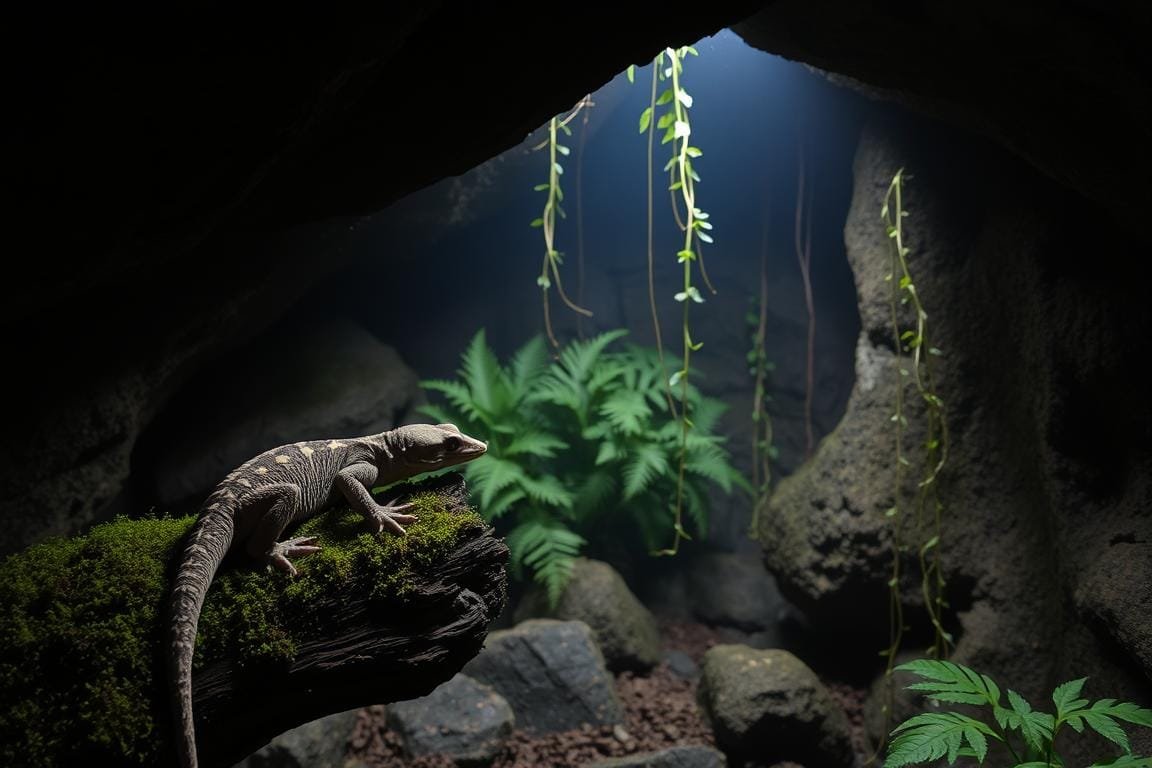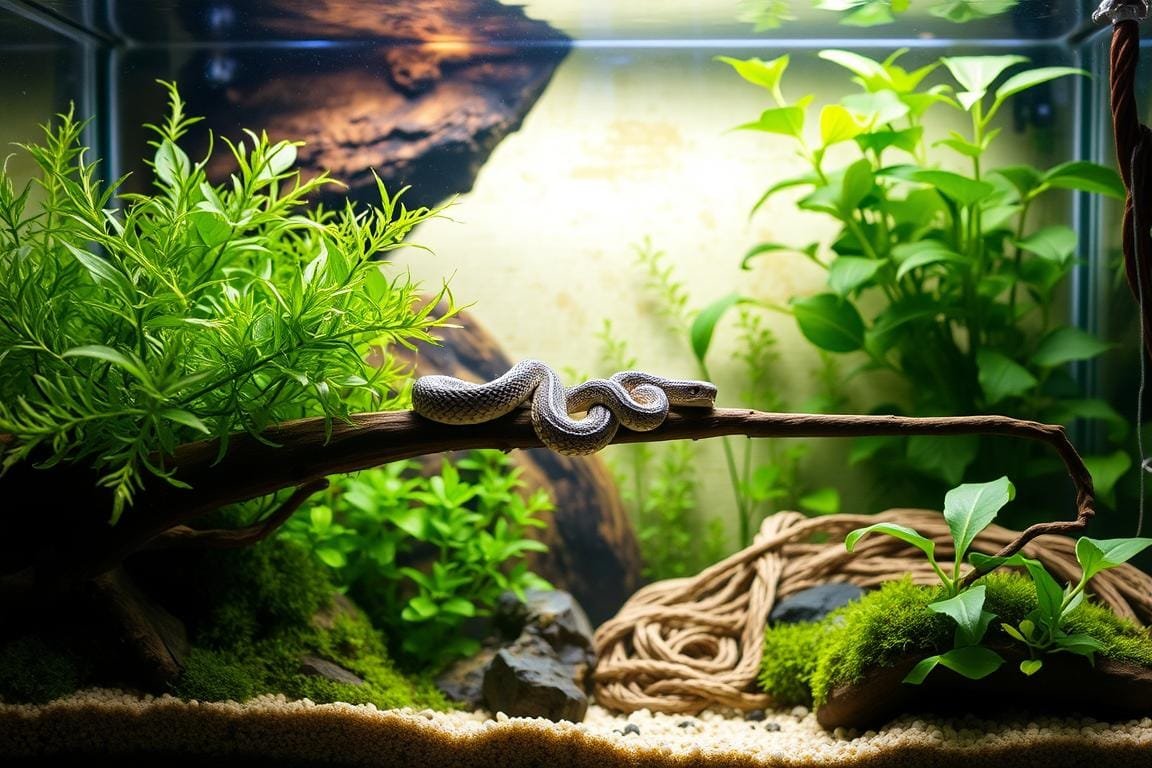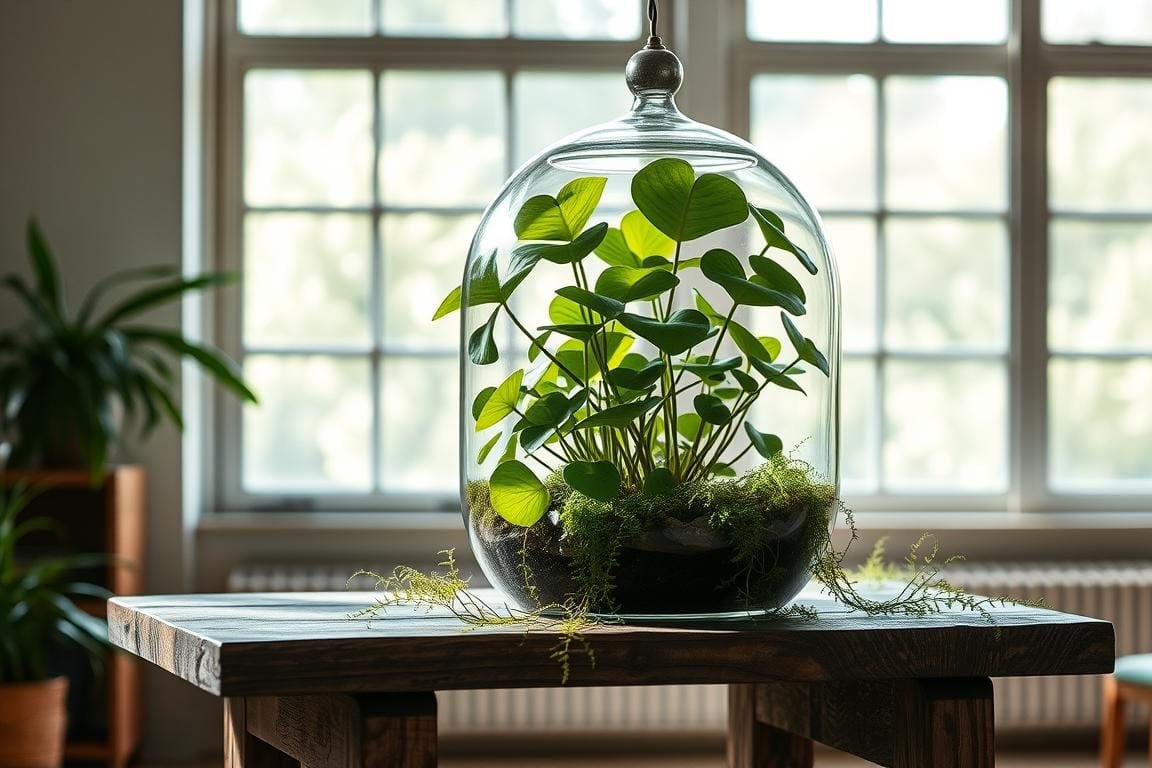Designing a home for unique reptiles requires more than just a tank and substrate. For species that thrive in rocky, forested environments, matching their natural surroundings is key to their health and happiness. This guide walks you through building a space that feels like their wild habitat while meeting all their needs.
These creatures rely on specific features like vertical climbing surfaces and shaded hiding spots. Adding textured backgrounds, cork bark, and live plants helps recreate the sheltered areas they prefer. Proper heat gradients and humidity levels also play a critical role in supporting their daily behaviors.
We’ll explore how to balance essential elements like temperature control, lighting options, and safe flooring materials. Whether you’re new to reptile care or refining your skills, our tips draw from trusted herpetology resources to ensure your setup promotes longevity. Get ready to craft a space where your scaled companion can truly flourish!
Understanding Chinese Cave Gecko Care & Habitat Fundamentals
Creating a thriving environment for these fascinating reptiles starts with understanding their wild roots. Native to Asia’s humid forests, they’ve evolved unique traits like functional eyelids and smooth toe pads—adaptations for navigating rocky terrain after dark.
Species Overview and Natural History
These small, nocturnal hunters thrive in shaded, moisture-rich ecosystems. Their mottled skin blends seamlessly with mossy rocks and decaying wood—a natural defense against predators. Wild populations maintain strict humidity ranges (70-80%) and moderate temperatures (72-78°F), which are critical to replicate in captivity.
Basic Care Requirements and Considerations
Proper care begins with space: a 20-gallon vertical setup allows climbing and hiding. Ventilation matters—too much airflow dries habitats, while too little encourages mold. Live insects like crickets or dubia roaches form their primary diet, dusted with calcium for bone health.
| Wild Habitat | Captive Needs | Why It Matters |
|---|---|---|
| High humidity | Misting systems | Prevents dehydration |
| Low light levels | Dim lighting | Reduces stress |
| Varied terrain | Cork bark ledges | Encourages exploration |
Observing behavior helps refine setups. If your pet avoids basking spots, adjust heat lamp placement. Nighttime activity spikes? Add more foliage for secure hiding. Small tweaks make big differences in their comfort!
Selecting and Setting Up Your Chinese Cave Gecko Enclosure
Building a comfortable home starts with smart space planning. Experts recommend starting with a 24”L x 18”W x 18”H terrarium for one adult—this gives enough room for climbing and hiding. Always prioritize vertical space over horizontal layouts to support natural behaviors.
Choosing the Right Habitat Size
Size directly impacts health and activity levels. Smaller setups restrict movement, while oversized tanks make heat regulation tricky. For younger reptiles, temporary 10-gallon containers work until they reach 4 inches in length.
Housing Options for Single and Multiple Geckos
While these creatures often live alone, small female groups (3 max) can coexist in 30-gallon tanks. Males fight aggressively, so never pair them. Always monitor group dynamics during feeding time.
| Setup Type | Minimum Size | Social Notes | Benefits |
|---|---|---|---|
| Single | 24″ x 18″ x 18″ | Ideal for beginners | Easier temperature control |
| Group | 30″ x 18″ x 24″ | Females only | Encourages natural interactions |
Daily misting maintains 70-80% humidity—use a pressure sprayer for even water distribution. Let your pet explore new decor items gradually to reduce stress. Proper care includes replacing UVB bulbs every 6 months, even if they still emit light.
Essential Elements of a Chinese Cave Gecko Enclosure
Crafting a habitat that mirrors natural conditions requires attention to three core systems: temperature regulation, lighting balance, and terrain design. These elements work together to support daily activities like hunting, climbing, and resting.
Heating, Lighting, and UVB Installation
Maintain a warm zone (80-85°F) using Exo Terra Daytime Heat Lamps, paired with cooler areas for natural thermoregulation. Place heat sources on one side to create essential temperature variations. UVB lamps like the Arcadia T5 SO ShadeDweller should span ⅓ of the habitat, replaced every 12 months to ensure proper vitamin D3 synthesis.
Digital thermometers help track gradients, while timers automate day/night cycles. Always position heating products above climbing surfaces—never directly on the floor—to prevent burns.
Substrate, Decor, and Enrichment Ideas
Choose moisture-retaining mixes of organic topsoil and coconut fiber for burrowing instincts. Add leaf litter for natural foraging behavior. A shallow water bowl with smooth edges prevents spills and supports hydration.
Rotate decor items like cork rounds and magnolia branches every few weeks to stimulate exploration. Live plants such as pothos or snake plants boost humidity while purifying air. For long-term success, refresh substrate every 4-6 months and sanitize decor during cleanings.
| Element | Recommended Products | Maintenance Tip |
|---|---|---|
| Heating | Ceramic heat emitters | Check nightly with IR thermometer |
| Lighting | Arcadia JungleDawn LED | Replace bulbs biannually |
| Substrate | BioDude Terra Fauna | Spot-clean weekly |
Temperature and Humidity: Creating the Ideal Microclimate

Balancing warmth and moisture transforms your pet’s habitat from basic to biologically precise. Reptiles rely on these factors for digestion, shedding, and energy regulation. Let’s break down how to achieve stability without guesswork.
Thermal Gradient Setup
Create distinct temperature zones using a low-wattage heat lamp on one side. Daytime basking areas should reach 80-82°F, while cooler spots stay 72-75°F. At night, let temperatures naturally drop to 70-75°F to mimic wild conditions.
Digital thermometers placed at both ends of the habitat help track gradients. Pair ceramic heat emitters with timers for consistent cycles. This setup lets your pet choose comfort levels, reducing stress.
| Parameter | Daytime | Nighttime | Tools |
|---|---|---|---|
| Temperature | 80-82°F (warm) | 70-75°F | Exo Terra Digital Thermometer |
| Lighting | 12-hour UVB cycle | Moonlight LED | Arcadia ShadeDweller |
Effective Humidity Control Techniques
Maintain 70-80% humidity with morning and evening misting sessions. Use an Exo Terra Mister for even coverage without waterlogging the substrate. Add sphagnum moss to corners for localized moisture pockets.
Hygrometers with memory functions track daily highs and lows. If levels dip below 60%, add a shallow water dish or increase misting frequency. Proper airflow prevents mold while keeping humidity stable.
Even nocturnal reptiles benefit from subtle UVB lighting. It supports vitamin D3 synthesis for calcium absorption. Combine this with calcium-dusted insects like roaches for complete nutrition.
Feeding, Nutrition and Supplementation for Chinese Cave Geckos
Proper nutrition fuels your pet’s health and vitality. Let’s explore how to balance live prey with essential supplements for optimal well-being.
Recommended Insect Diets
Offer gut-loaded crickets and dubia roaches as primary food sources. Juveniles need daily feedings, while adults thrive eating every other day. Rotate between 3-4 insect types to prevent nutritional gaps.
Mealworms should be limited—their hard exoskeletons can cause digestive issues. Always remove uneaten prey to reduce stress. A varied diet supports energy levels and natural hunting behaviors.
| Feeder Insect | Benefits | Frequency | Notes |
|---|---|---|---|
| Crickets | High protein | 3x weekly | Gut-load with carrots |
| Dubia Roaches | Low chitin | 2x weekly | Ideal for adults |
| Mealworms | Occasional treat | 1x monthly | Remove heads |
| BSFL | Calcium-rich | 1x weekly | No dusting needed |
Vitamin and Calcium Supplement Guide
Dust insects with Repashy CalciumPlus LoD before each feeding. This all-in-one formula covers calcium, D3, and trace minerals. For juveniles, supplement every meal; adults need it 3x weekly.
Use a digital thermometer to maintain warm-side temperatures (80-85°F)—critical for digestion. Cooler areas should stay 72-75°F. A balanced heat mix lets your pet process nutrients effectively.
Pair supplements with a shallow water dish and misted plants for hydration. With consistent care, you’ll see glossy scales and active behaviors!
Maintenance, Cleaning and Routine Care for Your Enclosure

Maintaining a pristine habitat is the cornerstone of your pet’s long-term wellness. Consistent care prevents health issues and keeps your scaled friend active. Let’s break down simple routines that fit seamlessly into busy schedules.
Daily and Weekly Cleaning Practices
Spot-clean each morning using tongs to remove waste and leftover feeders. Pay extra attention to mealworms—their hard shells can mold quickly if buried. Wipe glass surfaces with vinegar-water mix to maintain visibility.
Weekly deep cleans involve:
| Task | Frequency | Tools | Notes |
|---|---|---|---|
| Full substrate replacement | Every 3-4 months | Bioactive mix | Prevents odor buildup |
| Decor sterilization | Monthly | Rescue RTU spray | Kills 99.9% bacteria |
| Bowl scrubbing | Weekly | Reptile-safe brush | Prevents biofilm |
Handle feeders like crickets and roaches with care—wash hands after contact to avoid cross-contamination. Groups of decor items should be rotated during cleanings to stimulate natural behaviors.
Remember: Proper humidity requirements (70-80%) make shedding effortless. Check moisture levels when misting, and replace sphagnum moss every 2 months. With these steps, you’ll create a sanctuary that supports vibrant health for years!
Troubleshooting and Optimizing Enclosure Conditions
Even well-planned habitats can develop unexpected challenges. Spotting subtle signs early helps prevent minor issues from becoming health risks. Let’s explore practical fixes to keep your pet thriving.
Identifying Common Issues
Mismatched temperatures top the list of concerns. If your Goniurosaurus hainanensis avoids the basking area, check heat lamp placement with an Exo Terra digital thermometer. Ideal warm zones stay between 80-85°F—anything higher risks dehydration.
Low humidity often shows as incomplete sheds. Use a hygrometer to confirm levels stay above 70%. For quick fixes, add sphagnum moss near hiding spots or upgrade to a misting system. Refer to species-specific care sheets to verify your adjustments match natural needs.
Adjusting Setup for Long-Term Health
Reposition UVB lamps if your pet becomes lethargic. The Arcadia ShadeDweller works best when covering ⅓ of the habitat. Rotate decor monthly to stimulate natural behaviors—cork bark tunnels and slate ledges encourage climbing.
| Problem | Signs | Solution |
|---|---|---|
| Heat stress | Panting, glass surfing | Lower basking area by 2-3 inches |
| Poor digestion | Undereaten prey | Add infrared heat mat (Exo Terra) |
| Mold growth | White fuzzy patches | Increase airflow with mesh vents |
Make sure changes happen gradually—sudden shifts in lighting or temperature shock delicate systems. Track progress in a journal, noting improvements in activity or feeding responses. With patience and observation, you’ll master the art of fine-tuning habitats!
Final Reflections on Creating a Successful Gecko Habitat
Crafting a thriving habitat for your scaled companion combines science and artistry. By balancing thermal gradients, humidity cycles, and UVB lighting, you replicate the Hainan cave ecosystem they evolved to love. This harmony supports natural behaviors—from midnight hunts to flawless shedding.
Consistency is key. Pair misting routines with quality supplements like calcium-dusted dubia roaches for robust health. Trusted tools—Arcadia ShadeDweller lamps or digital hygrometers—take guesswork out of daily care. Rotate climbing structures monthly to spark curiosity.
Remember: Small tweaks make big impacts. If your pet avoids basking zones, adjust heat lamp heights. Notice incomplete sheds? Boost moisture with sphagnum moss. Every observation fine-tunes their Hainan cave-inspired haven.
With patience and these strategies, you’ll create more than a habitat—you’ll build a legacy. A space where generations of dubia roaches become meals, where UVB lighting fuels vitality, and where your care translates into decades of scaled companionship. Happy habitat crafting!





